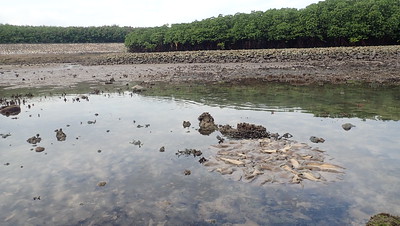In the last of the morning low spring tides of the year, we survey Pulau Semakau next to the Semakau Landfill and near petrochemical plants on Pulau Bukom.
Despite its location, this shore has living reefs with giant anemones, anemonefishes and lots more. The team found 5 Giant clams!
How nice to see Clown anemonefishes in a Giant carpet anemone. Did you know, the biggest fish in the anemone is a female? All the others are male, even the tiny ones (they are not baby fish). When the female dies, the biggest male changes sex and becomes the female in the anemone!
Other interesting sights for me were huge clusters of Magnificent anemones. As well as some glittery reef fishes and stealthy octopuses. I generally only manage to see super common nudibranchs. The rest of the team saw a lot more and in total, the team saw 5 Giant clams today! I didn't see a single one.Richard shared this photo of the large Fluted giant clam in the middle of the flats that everyone saw except me
Richard saw three Long-horned cowfish! Jianlin saw one. Unusual to see so many of these fishes at one time.
There are dense clusters of soft corals and other marine life right next to the wall that forms the Landfill.
When the Landfill was created in the 1990s, a lot of original mangroves on Pulau Semakau were killed. There was an effort to replant huge tracts of mangroves to make up for this loss. These replanted mangroves stand behind the seawall and are still doing well today. Shallow pools remain near the seawall and the mangroves even at low tide.
In this sheltered area, I saw a cluster of small Circular mushroom corals! There were about 20 of them, and scattered nearby, a few much larger ones. The area is dominated by Button zoanthids and Broad feathery soft corals. I also saw a Wiggly reef anemone, several Giant carpet anemones, a few small Leathery soft corals and Flowery soft corals, and some Anemone corals too. I also saw a Durian sea cucumber which is only common on Semakau.Richard also saw a File snake here!
The edge of this part of Pulau Semakau has lots of hard corals as well as leathery soft corals.
But I sense the hard corals are not doing as well as they were on our last survey in Dec 2020. Today, I saw many large to huge colonies with mostly dead portions and living portions only on the bottom most part. I also saw some Boulder pore corals with recently dead tissues (grey or whitish). But I didn't see any mass coral bleaching. And I did see many well formed small coral colonies of various kinds.There is a small stretch of sandy shore near the Landfill seawall.
It is teeming with life, mostly buried in the sand. There were signs of Acorn worms, Sand bubbler crabs. Burrowing Oval moon snails, Gong gong snails and even Moon crabs. I saw a large Fire anemone and a Mangrove horseshoe crab too.
There is not a lot of seagrass on this part of Pulau Semakau. There are small clumps of Tape seagrass scattered everywhere on the shore from the seawall to the reef edge. I saw some with long leaves, but most still had cropped leaves. There are very few small patches of Spoon seagrass with tiny leaves, most were heavily covered in epiphytes.
More about Pulau Semakau
Just as Changi Airport and Changi Beach are not the same even though they are near one another and share a name, Pulau Semakau is NOT the same as the Semakau Landfill. The Landfill was created by destroying all of Pulau Saking, and about half of the original Pulau Semakau by building a very long seawall. Fortunately, the landfill was constructed and is managed in such a way that the original mangroves, seagrass meadows and reefs on Pulau Semakau were allowed to remain. It is NOT true that the construction of the Landfill created the marine life found on Pulau Semakau. The marine life was there long before the Landfill was built.
What is the fate of this shore?
The 2013 landuse plan by the Ministry of National Development released in response to 2013 Population White Paper shows plans for 'possible future reclamation' (in light blue surrounded by dotted lines) that may impact the eastern shore of Pulau Semakau. More about the possible impact of the 2030 Landuse Plan on our shores.
Let's hope these shores will be spared this fate.
The Singapore Blue Plan 2018
Pulau Semakau and nearby islands and submerged reefs have been recommended by the Singapore Blue Plan 2018 for Immediate Conservation Priority.
The Blue Plan recommends the intertidal and subtidal marine areas of Pulau Semakau and adjacent Pulau Hantu, and Pulau Jong to be designated Marine Reserve.
The Blue Plan highlights that Pulau Semakau and its associated patch reefs comprise many ecosystems: coral reefs, mangrove areas, intertidal sandflats, seagrass meadows, and coral reefs. The subtidal area of Pulau Jong is larger than the terrestrial area. Pulau Hantu is a popular dive site has seen increasing interest in the past decade due to biodiversity awareness. If protection is accorded to these three islands, zonation plans for use can be implemented to manage tourism and human impacts.
DOWNLOAD the Plan, SUPPORT the Plan! More on the Singapore Blue Plan 2018 site.
Photos by others on this survey
Richard Kuah
Loh Kok Sheng
Jianlin Liu
Vincent Choo















